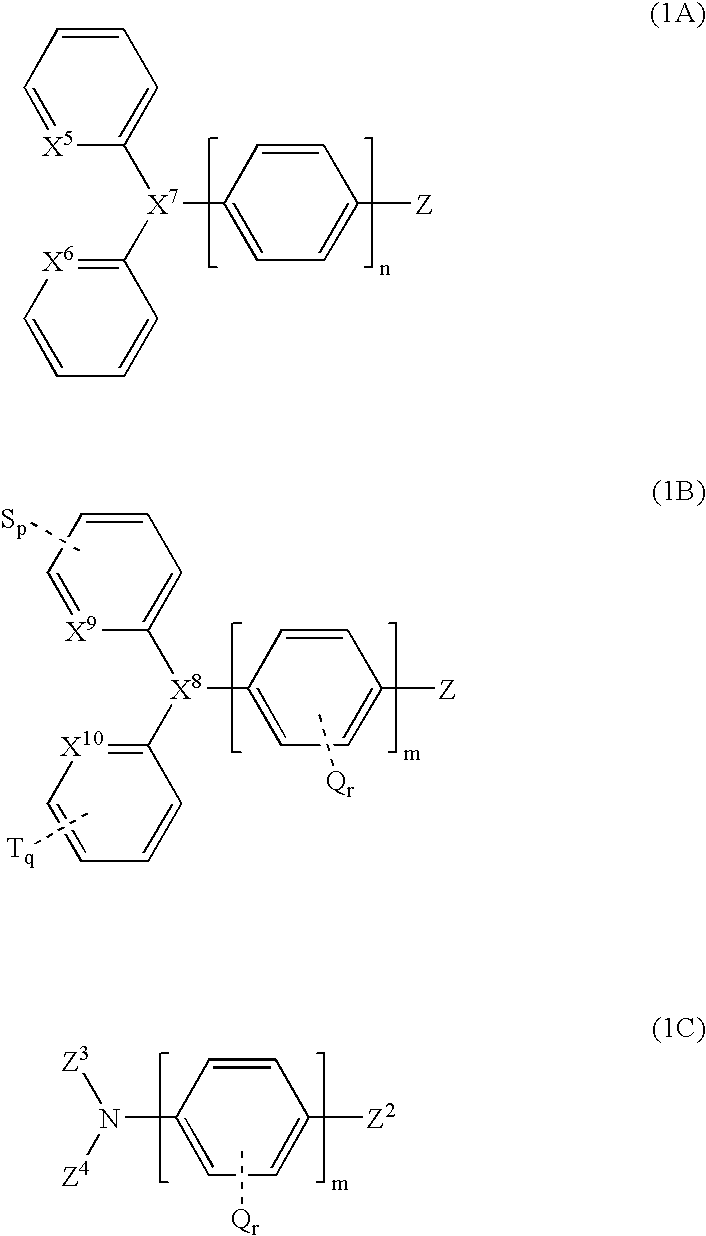Organic luminescent compounds and methods of making and using same
a luminescent compound and organic technology, applied in the direction of discharge tube luminescnet screens, thermoelectric devices, natural mineral layered products, etc., can solve the problems of lack of long-term stability in oleds, gradual deterioration of color purity of display, and many challenges to be addressed. , to achieve the effect of improving contact, improving contact, and improving conta
- Summary
- Abstract
- Description
- Claims
- Application Information
AI Technical Summary
Benefits of technology
Problems solved by technology
Method used
Image
Examples
working examples
[0163] All starting materials were purchased from Aldrich Chemical Company and used without further purification. Solvents were freshly distilled over appropriate drying reagents. All experiments were carried out under a dry nitrogen atmosphere using standard Schlenk Techniques unless otherwise stated Thin Layer Chromatography was carried out on SiO.sub.2 (silica gel F254, Whatman). Flash chromatography was carried out on silica (silica gel 60, 70-230 mesh). .sup.1H and .sup.13C spectra were recorded on a Bruker Avance 300 spectrometer operating at 300 and 75.3 MHz respectively. Excitation and emission spectra were recorded on a Photon Technologies International QuantaMaster Model 2 spectrometer. Spin coating was done on Chemat Technology spin-coater KW-4A and vacuum deposition using a modified Edwards manual diffusion pump. The EL spectra for compound (3) (see FIG. 8) were taken using Ocean Optics HR2000 and all data involving current, voltage and luminosity using a Keithley 238 hi...
example 1
1-pyrenyl-2, 2 dipyridylamine (2)
[0164] The mixture of 0.145 g, 1-bromopyrene (0.5 mmol), 0.10 g 2,2 dipyridylamine (0.58 mmol), 0.125 g CuI, 0.235 g K.sub.3PO.sub.4, 0.033 mL 1,2-transdiaminocyclohexane and 1 mL 1,4-dioxane was stirred at 110.degree. C. for 24 hours. After cooling to room temperature, the mixture was extracted with dichloromethane (3.times.15 mL). The solvent was evaporated under reduced pressure. The residue was subjected to column chromatography on silica gel (CH.sub.3COOEt / Hexane, 2:1) to afford a white compound (2) in 39% yield. The molecular structure of (2) was confirmed by X-ray crystallography, the structure is pictured in FIG. 9. .sup.1H NMR in CD.sub.2Cl.sub.2 at 25.degree. C.: .delta. ppm=8.31(d, J=8.1, 1H), 8.27(m, 3H), 8.19 (m, 3H), 8.06(m, 3H), 7.95 (d, J=8.1, 1H), 7.56 (m, 2H), 7.08(td, d=8.4, 0.9, 2H), 6.94(ddd, J=7.2, 4.8, 1H). .sup.13C NMR in CD.sub.2Cl.sub.2 at 25.degree. C., 6 ppm: 159.08, 148.72, 139.16, 137.94, 131.81, 131.62, 131.12, 129.65, ...
example 2
Synthesis of 4-(1-pyrenyl)phenyl-2.2'-dipyridylamine (3)
[0165] A mixture of 1-bromopyrene (0.5 g, 1.78 mmol), Pd(PPh.sub.3).sub.4 (0.062 g, 0.054 mmol) and toluene(40 mL) was stirred for 10 minutes under N.sub.2(g). A solution of p-(2,2'-dipyridylamino)phenylboronic acid (0.57 g, 1.96 mmol) in 20 mL EtOH and a solution of NaOH (0.8 g) in 20 mL H.sub.2O were added. The resulting mixture was heated and stirred at reflux for 24 hours and was then allowed to cool to room temperature. The water layer was separated and extracted with methylene chloride (CH.sub.2Cl.sub.2) (3.times.15 mL). The combined organic layers were dried over MgSO.sub.4, and evaporated under reduced pressure. Purification of the crude product was performed by column chromatography (THF:Hexane, 3:2) and afforded (3) as a white solid in 83% yield. The molecular structure of (3) was confirmed by X-ray crystallography, the structure is pictured in FIG. 10. .sup.1H NMR in CD.sub.2Cl.sub.2 at 25.degree. C.: .delta. ppm=8.4...
PUM
| Property | Measurement | Unit |
|---|---|---|
| temperature | aaaaa | aaaaa |
| thick | aaaaa | aaaaa |
| thickness | aaaaa | aaaaa |
Abstract
Description
Claims
Application Information
 Login to View More
Login to View More - R&D
- Intellectual Property
- Life Sciences
- Materials
- Tech Scout
- Unparalleled Data Quality
- Higher Quality Content
- 60% Fewer Hallucinations
Browse by: Latest US Patents, China's latest patents, Technical Efficacy Thesaurus, Application Domain, Technology Topic, Popular Technical Reports.
© 2025 PatSnap. All rights reserved.Legal|Privacy policy|Modern Slavery Act Transparency Statement|Sitemap|About US| Contact US: help@patsnap.com



